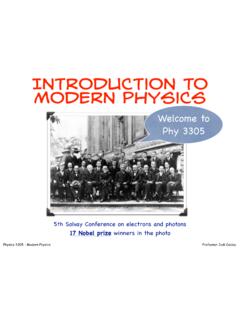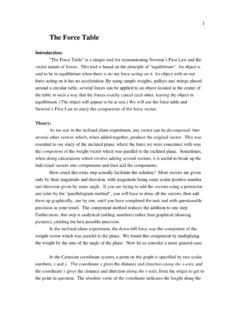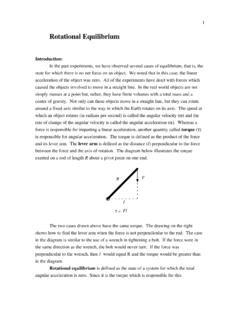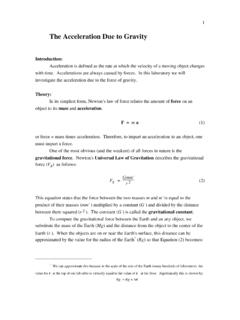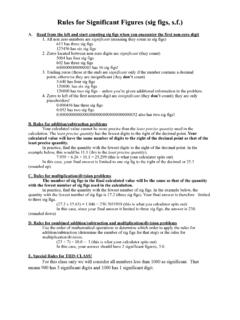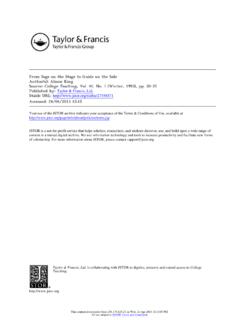Transcription of Chapter II: Reciprocal lattice - SMU
1 Chapter II: Reciprocal latticeRead Chapter 2 of KittelHow can we study crystal structure? Need probe that can penetrate into crystal X-rays, neutrons, (high energy electrons) X-rays discovered by Roentgen in 1895- instant sensation round the world - view of his wife s hand Neutrons (discovered in 1932) penetrate with almost no interaction with most materialsHow can we study crystal structure? X-rays scatter from the electrons - intensity proportional to the density n(r) - Mainly the core electrons around the nucleus Similarly for high energy electrons Neutrons scatter from the nuclei (and electron magnetic moment) In all cases the scattering is periodic - the same in each cell of the crystal Diffractionis the constructive interference of the scattering from the very large number of cells of the crystalThe crystal can be viewed as made upof planes in different ways Low index planes: more lattice points, more widely spaced High index planes: less lattice points, more closely spaced Bragg model: incident waves are reflected specularlyfrom parallel planesa1a2 lattice (01)(14)Bragg Scattering Law Condition for constructive interference.
2 2d sin = n Maximum = 2d Thus only waves with of order atomic size can have Bragg scattering from a crystald d sin Single crystal diffraction Crystal must be oriented in all directions in 3D space using Gonier Spectrometer Observe scattering only at Bragg angles for a fixedwavelength x-ray or neutrons or .. Rotate both sample and detector about axis2 Alternative approach -energy dispersive diffraction For fixed angle , vary the energy ( , ) to satisfy Bragg condition X-rays over broad energy range now available at synchrotrons Diffraction (Bragg scattering) from a single crystallite used toselect X-rays with desired wavelength electronsPhotons - broadrange of energiesSingle crystalmonochrometerExperimentPhotons with selected energyScattered wave amplitude The Bragg law gives the condition for the constructive interference of waves scattered from lattice planes. We need a deeper analysis to determine the scattering intensityfrom the basis of atoms, from the spatial distribution of electrons within each cell.
3 We will use the periodicity of the electron number densityn(r) to perform Fourier analysis. We end up with a second lattice associated with the crystal Reciprocal latticePeriodic Functions and Fourier Analysis Any periodic function can be expressed in terms of its periodic Fourier components (harmonics). Example of density n(x) in 1D crystal:n(x) = n0+ p>0[Cpcos (2 p x/a) + Spsin (2 p x/a) ] Easier expression:n(x) = p npexp( i 2 p x/a)(easier because exp( a + b) = exp( a ) exp( b) ) Expression for Fourier Components:np= a-1 0adx n(x) exp( - i 2 p x/a)Periodic functions and Fourier Analysis Define vector position r = (x,y) (2D), r = (x,y,z) (3D). Fourier analysisf(r) = GfGexp( i G r) where the G s are vectors, , exp( i G r) = exp( i (Gxx + Gyy + Gzz) ) A periodic function satisfies f(r) = f(r+ T) where Tis any translationT(n1,n2,..) = n1a1+ n2a2(+ n3a3in 3D),where the n s are integers Thusf(r+ T) = GfGexp( i ) exp( i G T) = f( r) exp( i G T) = 1 G T= 2 xinteger Reciprocal lattice The Reciprocal lattice is the set of vectors G in Fourier space that satisfy the requirement G T= 2 xinteger for any translation T(n1,n2.)
4 = n1a1+ n2a2(+ n3a3in 3D) How to find the G s ?? Define vectors biby bi aj= 2 ij, where ii= 1, ij= 0 if i j If we define the vectorsG(m1,m2,..) = m1b1+ m2b2(+ m3b3in 3D),where the m s are integers, then clearly G T= 2 xinteger for any TReciprocal lattice and Translations Note: Reciprocal lattice is defined onlyby the vectorsG(m1,m2,..) = m1b1+ m2b2(+ m3b3in 3D),where the m s are integers andbi aj= 2 ij, where ii= 1, ij= 0 if i j The onlyinformation about the actual basis of atoms is in the quantitative values of the Fourier components fGin the Fourier analysisf(r) = GfGexp( i G r) Inversion:fG= Vcell-1 celldrf(r) exp(- i G r) Reciprocal lattice and Fourier Analysis in 1D In 1D, b = 2 /a, b and aparallel Periodic function f(x): f(x) = p fpexp( i 2 p x/a)= p fpexp( i p b), p = integer The set of all integers xb are the Reciprocal latticeabReal & Reciprocal lattices in 2 D Two lattices associated with crystal lattice b1perpendicular to a2, b2perpendicular to a1 Wigner-Seitz cell of Reciprocal lattice called the First Brillouin Zone or just Brillouin Zone a1a2b2b1b2b1 Wigner-Seitz CellBrillouin Zonea1a2Ex.
5 What is the relationship between b1and b2, if a1>a2? Reciprocal lattice in 3D The primitive vectors of the Reciprocal lattice are defined by the vectors bithat satisfy bi aj= 2 ij, where ii= 1, ij= 0 if i j How to find the b s? Note: b1is orthogonal toa2 anda3, etc. In 3D, this is found by noting that (a2xa3) is orthogonal toa2anda3 Also volume of primitive cell V = |a1 (a2xa3)| Then bi= (2 / V ) (ajxak), where (i, j, k) = (1,2,3), (2,3,1) or (3,1,2)2/z 2/y 2/x + =1a2/z 2/y 2/x +=2a222/z /y /x ++ =3akjiaab =V 2Ex. Write the primitive vectorsof the Reciprocal lattice in termsof z,y,x Real and Reciprocal lattice (recall Bravais exercises) the Reciprocal vector G= h b1+ k b2+ l b3is perpendicular to the real lattice plane with index (h k l) the distance between two consecutive (h k l) planes is See also Problem in KittelG ndhkl2=Scattering and Fourier Analysis The in and out waves have the form: exp( i t) and exp( i t) If the in wave drives the electron density, which then radiates waves, the outgoing amplitudeis proportional to:F= spacedr n(r) exp(i (kin-kout) r)d kinkout Scattering and Fourier Analysis Define k= kout-kint Then we know from Fourier analysis that F = spacedrn(r) exp(- i ) = N cellV cellnGonly if k= G,where G = recip .
6 Lat. vector Otherwise integral vanishes no diffraction nG= V cell-1 celldrn(r) exp(- i G r)The set of Reciprocal lattice vectors determines thepossible x-ray reflectionsd k= Gkinkout Elastic Scattering For elastic scattering (energy the same for in and out waves) | kin| = | kout|, or kin2= kout2= ( kin + G)2 Then one arrives at the condition for diffraction: 2 | |= G2d k= Gkinkout Ewald Constructionkout= kin +G| 2 kin G| =2 | kin || G| cos (90 + )= 2| kin || G| sin l 2= ka3kinkoutG2 90 Laue equations: k 2= ka2h 2= ka1 Equivalent to Bragg Condition From last slide, since G2= | G|2: | G|= 2| kin |sin But | kin | = 2 / , and | G | = n (2 /d), where d = spacing between planes (see Kittel prob. ) Bragg condition 2d sin = n kinkoutG2 Geometric Construction of Diffraction Conditions Consequence of condition | 2 kin G| = G2 | kin G/2 | = (G/2)2 The vector kin(also kout) lies along the perpendicular bisecting plane of a Gvector One example is shownb2kinb1koutGDiffraction and the Brillouin Zone Brillouin Zone formed byperpendicular bisectors of Gvectors Consequence:No diffraction for any kinside the first Brillouin Zone Special role of Brillouin Zone (Wigner-Seitz cell of Reciprocal lattice ) as opposed to any other primitive cell b2kinBrillouin Zoneb1koutGComparison of diffraction from different lattices The Bragg condition can also be written | G|= 2| kin|sin sin = ( /4 ) | G| Thus the ratios of the sines of the angles for diffraction are given by.
7 Sin 1/sin 2= | G1| / | G2| Each type of lattice has characteristic ratios the positions of diffraction peaks as a function of sin Simple scaling with Experimental Powder Pattern Diffraction peaks at angles satisfying the Bragg conditionDifferences for imperfect powderaveragesReciprocal lattice analysis of the basis The intensity of the diffraction at each Gis proportional to the square of the scattering amplitude F = N celldrn(r) exp(- i )= NSG SG structure factor Regard the crystal density n(r) as a sum of atomic-like densities natom(r-Ri), centered at point Rin(r) = all inatom i ( r-Ri) Then also SG= i in cell spacedrnatom i (r-Ri) exp(- i G r)CellOne atom per cell and Form Factor Then one can set Ri= 0 and SGis the Fourier transform of one atom densityf = spacedrnatom(r) exp(- i G r) Called Form Factor In the limit of point-like atoms f=Znatom(r)|r||G|fValues of |G| for aparticular crystalMore than one atom per cell SG= i in cell spacedrnatom i ( r-Ri) exp(- i G r)= i in cellexp(- i G Ri) spacedr natom i ( r-Ri) exp(- i G (r-Ri) ) = i in cellexp(- i G Ri) spacedr natom i ( r) exp(- i G r) = i in cellexp(- i G Ri) fGatom i Interpretation: Form factorfGatom iand phase factorexp(- i G.)
8 Ri) for each atom in unit cellStructure factor and atomic form factor The amplitude of the scattered electromagnetic wave is The structure factor of the base is The atomic form factorGGNSF= =cell in ii atomGG)iexp(fSiRG)iexp()r(n dVffcell unitjj atomGjrG == Pure Structure factor Often the basis contains more than one atom that is same element, , diamond structure Then fGatom i= fGatom is the same andSG= i in cellexp(- i G Ri) SG atom i= fGatom i in cellexp(- i G Ri) Define pure structure factorS0G= (1/n) i in cellexp(- i G Ri)where n = number of atoms in cell Then SG= n S0G fGatomBody Centered Cubic viewed as Simple Cubic with 2 points per cellS0G= (1/2) i =1,2exp(- i G Ri)= (1/2) ( 1 + exp(- i G R2) = (1/2) exp(- i G R2/2) [exp( i G R2/2) + exp(- i G R2/2) ] = exp(- i G R2/2) cos ( G R2/2) Result: If G= (v1v2 v3) 2 /a|S0G | = 1 if sum of integers is even| S0G| = 0 if sum is oddSame as we found before!
9 FCC Reciprocal latticeaa1a3a2 Points at R1= (0,0,0)R2= (1,1,1) a/2 Face Centered Cubic viewed as Simple Cubic with 4 points per cellaa1a2a3 Points at (0,0,0) ; (1,1,0) a/2 ; (1,0,1) a/2 ; (0,1,1) a/2 S0G= (1/4) i =1,4exp(- iG . Ri)Result:If G = (v1v2 v3)2 /athenS0G= 1 if all integers are odd or all are evenS0G= 0 otherwiseSame as we found before! BCC Reciprocal latticeStructure factor for diamond Ex: diamond structureS0G= (1/2) i =1,2exp(- i G . Ri) R1= + (1/8, 1/8, 1/8)aR2= - (1/8, 1/8, 1/8)a
